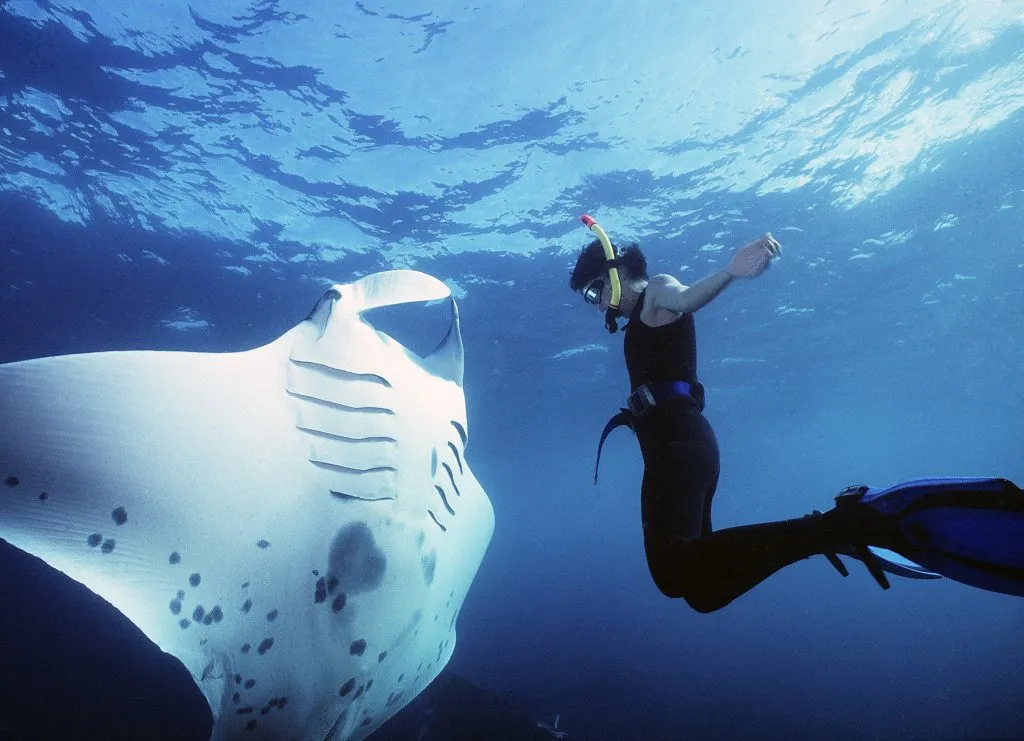

What Makes Manta Bay Special?
Nusa Marina Wisata
06:07:48 July 15, 2025
in
Blog,Nusa Penida
Manta Bay is famed for its gentle giant inhabitants: the majestic manta rays, some with wingspans reaching up to five meters. Drawn by plankton-rich waters, these curious and graceful creatures often swim close to the surface, creating unforgettable moments for snorkelers. Unlike Manta Point—which caters mainly to experienced divers in rougher, deeper waters—Manta Bay is perfectly suited for snorkelers, making close encounters with manta rays accessible to nearly everyone, regardless of scuba qualifications.
What to Expect on a Manta Bay Visit
Snorkeling & Marine Life
You’ll head out by boat—most tours depart from Toyapakeh Harbour on Nusa Penida, but many options also leave from Bali and Nusa Lembongan.
Tours typically last about three hours and include stops at Manta Bay, as well as other breathtaking snorkeling spots like Gamat Bay and Crystal Bay.
Besides manta rays, expect a kaleidoscope of marine life: vibrant corals, colorful reef fish, and perhaps even sea turtles or playful dolphins.
The Manta Ray Experience
Spotting mantas is never guaranteed, but chances are excellent between May and September, when plankton is abundant.
When manta rays appear, you’ll witness their unique underwater ballet up close—sometimes alone, sometimes in groups as large as 20.
Swimming alongside these gentle giants is safe; mantas have no stingers and pose no threat to humans.
Practicalities
No entrance fee; you pay only for your snorkeling tour.
Best season: May–September for calm seas and increased manta sightings.
Accessibility: The bay is only reachable by boat. Water currents can be strong, so beginners should always go with guides or instructors.
| Manta Bay | Manta Point |
|---|---|
| For snorkelers, calm water | For divers only, rougher seas |
| Located NW Nusa Penida | Located on the south coast |
| Manta rays feed near surface | Cleaning stations, mantas deeper |
Conservation & Respect
The presence of such magnificent creatures highlights the importance of responsible tourism and conservation. By choosing operators who respect wildlife and local communities, your visit helps underscore the need to protect these ecosystems for future generations.
Insider Tips
Book early, especially in high season.
Bring a waterproof camera or GoPro—you’ll want proof of your manta moment!
Respect the mantas by maintaining a safe distance and never chasing or touching them.
Manta Bay is not just a travel destination—it’s a rare chance to connect intimately with ocean wildlife and support Bali’s vibrant marine ecotourism. Whether you’re a seasoned snorkeler or first-timer, it’s an awe-inspiring adventure you’ll remember for a lifetime.
What tips can help me capture the best photos of manta rays at Manta Bay
To capture the best photos of manta rays at Manta Bay, focus on these expert photography strategies:
: Mantas are large and often come close, so a wide or fisheye lens (for example, 10–17mm on SLR, or a wet wide lens for compacts) helps fit their whole wingspan into your frame and makes the most of dramatic encounters.
: The sun is your most powerful tool—position yourself so that the sun is behind you to enhance color, contrast, and sharpness. For artistic silhouette shots, you can shoot towards the sun, but for vibrant detail, keep it at your back.
:
: Use a fast shutter speed, at least 1/250 sec, to freeze the graceful motion of the mantas’ wings.
: Start with f/5.6–f/8 for depth of field and sharpness.
: Balance ISO for exposure but avoid excessive noise—ISO 400–800 is a good starting point, adjusting as needed for light and camera capability.
for more flexibility in editing and to capture the dynamic underwater lighting.
Approach calmly and let mantas come to you: Stay relaxed and move as little as possible; mantas are naturally curious and will often approach closely if you wait patiently. Quick or aggressive movement can scare them away.
:
Shoot from a low angle upwards to include the blue water and create a dramatic effect.
Capture variety: include full-body shots, close-ups of unique features like cephalic lobes or underbellies, and interacting scenes with divers for scale.
Avoid crowding: position yourself away from other snorkelers to avoid bubbles or stray limbs appearing in your frame.
: If you use strobes, set them wide to minimize backscatter. For video, use a strong light only when mantas are close so as not to disturb them or lose color detail.
: Anticipate the manta’s path—often, after approaching, they flip and reveal their underside, so plan for varied shots and review your images between encounters to tweak your settings.
: Never chase or touch manta rays. Respectful, slow movement ensures the best chance of memorable photos and helps protect the animals for everyone.
These tips will help you capture stunning, respectful images of manta rays at Manta Bay—and ensure you fully enjoy the wonder of the moment as well.
Payment
Nusa Marina Wisata
Copyright © 2024. All rights reserved


